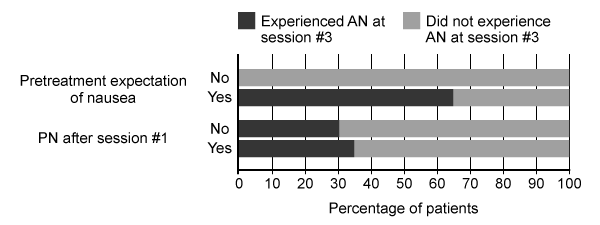Passage
Patients undergoing chemotherapy frequently experience a number of side effects in response to the cytotoxic drugs administered during treatment, including nausea and/or vomiting (N/V) , hair loss, fatigue, cognitive dysfunction, anemia, and others. However, there is ample evidence that learning and cognition may play a role in the development of some of these side effects. For example, 20%-30% of patients undergoing chemotherapy continue to experience N/V merely in the setting and presence of chemotherapy equipment even after taking antiemetic medication.Three studies were conducted to better understand the acquisition of a learned, anticipatory nausea (AN) response. Studies 1 and 2 used the classical conditioning principle of overshadowing, in which a powerful stimulus is presented alongside a less salient stimulus during the acquisition phase. This results in a stronger relationship between the salient stimulus and the response, as compared with the less salient stimulus and response.In Study 1, nausea was induced in 50 healthy volunteers through motion sickness in a rotating chair. Subjects were divided into two groups and drank specific beverages prior to the rotation: One group received a different novel-tasting beverage (eg, elderberry, sloe) each day, and the other group drank only water. Nausea-related symptoms were recorded before and after the rotation. Results showed that subjects who drank the novel-tasting beverages reported less AN than those who drank water.Study 2 tested the protocol from Study 1 in cancer patients undergoing chemotherapy. Immediately prior to chemotherapy infusion, one group received a different novel-tasting beverage each day and the other group drank only water. Results again demonstrated that subjects in the group with different novel-tasting beverages experienced less AN than those who drank water.Study 3 researchers investigated whether patients' pretreatment expectations of developing nausea or medication-induced post-chemotherapy nausea (PN) were a better predictor of subsequent AN. Before their first round of chemotherapy (session #1) , subjects were surveyed about their degree of certainty of developing nausea. PN was measured after session #1, and then AN was measured before session #3 (Figure 1) .
 Figure 1 AN before session #3
Figure 1 AN before session #3
J. T. Hickok, J. A. Roscoe, and G. R. Morrow ©2001 Elsevier; U. Stockhorst, P. Enck, and S. Klosterhalfen ©2007 Baishideng Publishing Group.
-Which of the following is NOT accurate regarding antiemetic medications, which are administered to patients undergoing chemotherapy to treat or prevent N/V?
A) An antiemetic that prevents a recurrence of N/V acts as positive reinforcement.
B) An antiemetic that treats current PN acts as negative reinforcement.
C) An antiemetic that treats current PN may produce escape learning.
D) An antiemetic that prevents a recurrence of N/V may produce avoidance learning.
Correct Answer:
Verified
Q244: To investigate attributions related to exercise, an
Q245: Passage
Patients undergoing chemotherapy frequently experience a number
Q246: Passage
In 2010, the United States (U.S.) had
Q247: Compared to women's social networks, men's social
Q248: Passage
During the 1800s, the United States (U.S.)
Q250: The following graph, depicting the foreign-born (immigrant)
Q251: In a surgical residency program that does
Q252: Passage
Patients undergoing chemotherapy frequently experience a number
Q253: Passage
Patients undergoing chemotherapy frequently experience a number
Q254: Passage
Patients undergoing chemotherapy frequently experience a number
Unlock this Answer For Free Now!
View this answer and more for free by performing one of the following actions

Scan the QR code to install the App and get 2 free unlocks

Unlock quizzes for free by uploading documents